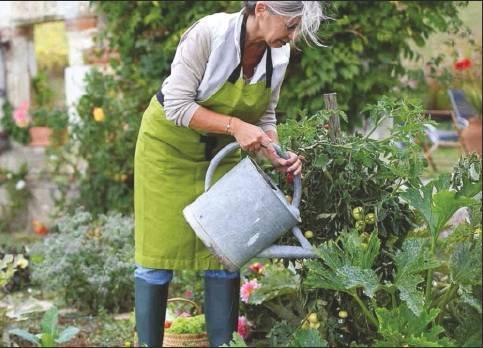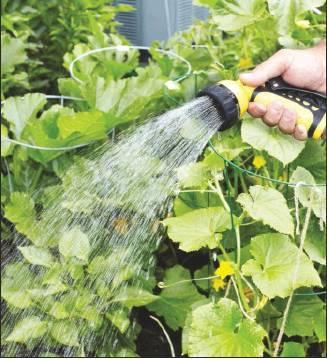Summer Yard and Garden Watering
According to the Environmental Protection Agency, 30% to 70% of the water consumed by America’s residential homes is used outdoors. Summertime lawn and garden watering can multiply household water use two to four times over what is used the rest of the year, and the truth is that most of that water is wasted.
While using the highest quality, water-wise products can make a difference, much of water conservation comes from the design of your landscape, especially the plants you choose to grow, and the ways water is applied to that landscape. Gone are the days in which we set the oscillating sprinkler out after lunch and let it run all afternoon.
There are some ways you can cut your outdoor water usage this summer. No doubt, many of us are already employing some of these recommendations, but it never hurts to cover them again, so here goes…
Make it a rule to never run sprinklers to water your garden. Sure, it’s easy to set the sprinkler to cover the entire garden and let it go. But much of the sprinkler water is lost to the breeze and evaporation. And different plants require different amounts of watering. We don’t want to over water one plant while we’re under watering another.
Hose and nozzle watering can also be wasteful. Keep the spray or shower of the water directed to each particular plant and use a trigger nozzle that allows use to quickly turn off water as you move between plants and rows. Nozzles with multiple settings and an on-off trigger are best, allowing you to adjust spray and pressure to avoid runoff or plant damage.
Hand-water small gardens (or specific plants) with a watering can. For those with the back and shoulders to hoist one, a watering can is perfect for applying water directly around the plant where it’s most needed.
If you have insects on your leaves, blasting them off with a spray of water can be wasteful where water is at a premium. Instead, hand-pick (or squash eggs and larvae right where you find them) and release beneficial insects. Or you can do what I do and use a rechargeable dust buster to remove those pesky insects.
Employ soaker hoses, drip irrigation, and other conservation-minded forms of garden irrigation as practical. If your watering system is on an automatic timer, make sure you use a rain or soil moisture detector to keep it from running when not needed. Otherwise, control your system manually, watering only when needed.
Mulch between plants and rows to slow evaporation from the soil. Thin plants to recommended spacing distance to avoid competition for soil moisture.
Know that lawns go dormant naturally during some part of the summer. It doesn’t hurt them to go dormant (though they’re more vulnerable to foot traffic) and you don’t have to water them during this time. If you’re watering your lawn during this period to keep it green, consider calculate how much it’s costing you.
Set your mower higher. Leave at least three inches of grass, three-and-ahalf for fescue, after each mowing. The added height shades the ground, slowing evaporation. Mowing shorter not only provides less protection for the soil, it allows quicker uptakes of water into the atmosphere.
Take the clippings bag off your mower and allow the cut grass to settle back into the yard. Think of these clippings as a kind of mulch that helps hold soil moisture in the ground. The decaying grass also encourages beneficial microbes that will help keep your turf healthy. And make sure that mower’s sharp. Damaged and crudely cropped grass that comes of dull mower blades require more water to heal.
Knowledge of grass’ needs and growing habits will help you cut down on watering. I’m not telling you anything you don’t know when I say that the best way to save on lawn water is to have a healthy soil. Good soil composition not only holds moisture well, it encourages plant health — deep rooting, steady, upright growth — that helps our lawns resist pests and smother weeds. Adding compost is a must, and if applied very lightly it’s not too late in the season to do it.
Proper watering is also necessary to encourage deep root growth. Longer grass encourages deeper rooting. Thorough watering early in the season followed by several days as the roots reach to get what’s there, will pay dividends as the season become drier. Watering in the morning to avoid evaporation is the common practice. Some people use the same reasoning to water at night.
One of the better tips to save water is that you stop adding chemical fertilizer to your lawn. Heavy lawn fertilization, especially the sort sprayed periodically on Texas yards by lawn care services, results in the grass needing more water. Not only does spraying (or chemical dry fertilizer) lock the water away from the grass, it also increases the grasses need for moisture to accommodate the false growth it triggers. Adding some compost in the spring (and fall, too) and letting the mowing clippings to settle back to the ground are really all the fertilizer a healthy lawn needs.
One theory suggests that you should hold off on summer watering until the lawn shows signs it needs it. This calls for close attention to the amount of water stress your grass is showing. If the individual blades begin to curl and roll, when you walk on grass and it doesn’t spring back under your feet, when the blades lose their usual glaze and shine; all these things indicate that it might be time to water. Some experts recommend that sticking a screwdriver into the soil can be revealing of water needs. You should be able to push the screwdriver in a good six inches before feeling much resistance, they say. But I advise caution with this method as you can be fooled doing this, especially if you have thick roots crowded near the soil surface or, like many of us, you have rocky soil just a couple inches down.
It’s important to remember that lawns naturally go dormant during the hot weeks of a dry summer. Of course, you can keep this from happening by watering an inch every few days. But the idea is to save water. And your local neighborhood, county, city, or state, authorities might just demand it by issuing watering restrictions. We have had them before and will have them again.
When your lawn starts to show symptoms like the ones above, make a commitment to quit watering. Yes, your lawn will turn brown, but this is what natural grasses do out on the deserts and prairies, it is how they have evolved to survive and thrive. Besides even if the top goes brown the roots survive to send up blades once moisture arrives. If you choose to let your yard go dormant, as I do, make a commitment. It stresses the lawn to no end if you allow it to go brown and then introduce more water only to allow it to go brown again. Let it stay brown.
The only real caution here is: don’t let it stay brown too long. Six or seven weeks is the maximum for most lawn grasses. Any moisture-less survival required after a month-anda-half of drought will result in dead patches and thin recovery. Finally, know your community’s watering restrictions. Consider them motivation to a healthy, sustainable lawn as well as doing something necessary for you and your neighbors. And you’ll save money, and who won’t be happy with that!




